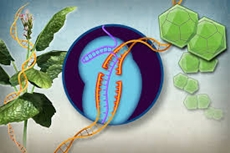‘CRISPR’ a viable option to GM foods
07 Sep 2016
It's not every day that two men sitting down to eat a plate of cabbage makes news around the world. But that's what recently happened when scientists ate a meal created using plants modified with 'genetic scissors' called CRISPR-Cas9.
 Researchers from Umeå University in Sweden served pasta with 'CRISPR' vegetables to a radio reporter. Scientists say that the meal marks the first step towards a future where science can better provide consumers around the world with healthy and hardy plant foods.
Researchers from Umeå University in Sweden served pasta with 'CRISPR' vegetables to a radio reporter. Scientists say that the meal marks the first step towards a future where science can better provide consumers around the world with healthy and hardy plant foods.
CRISPR-Cas9 is the 'Swiss army knife of genetic engineering' which can change the genes of an organism. Using the tool, researchers can either replace one of the billions of 'letters' present in the genome, or remove short segments – in the same way you could change a letter in a story, or a whole word.
This often happens naturally outside of the lab due to mutations which can change a letter or remove short segments. The tool is already being tested for clinical applications, and could soon cure hereditary diseases, such as Duchenne muscular dystrophy – which it has been shown to cure in mice.
But the situation somewhat differs in the agricultural field, due to legislation around genetic
Some people are voicing their opposition to the gene-editing technology. Earth Open Source, a European NGO funded by the Maharishi cult, recently attacked the claim that CRISPR was more accurate than previous genetic engineering tools.
However, the claim has since been disputed by Genetic Literacy Project, who said that ''the cult's description has little to do with the use of the technology in plants''.
David Stern, a plant biologist and president of the Boyce Thompson Institute for Plant Research, recently warned in a statement that people might perceive gene editing as 'playing God.' But he added. 'I think this is a price that must be paid for the many benefits gene-edited crops can bring to the agricultural space.'
After much debate, the US and Swedish authorities concluded that as CRISPR does not insert any foreign DNA, and only removes DNA, it is not regarded as a genetically modified organism (GMO).
This means that the technology is open to develop the plants of the future.
The researchers used CRISPR to modify a cabbage plant by removing a protein called PsbS, a so called ''safety valve in photosynthesis''.
In his blog, Professor Jansson wrote, 'To our delight – and to some extent my surprise – the meal turned out really nice.
''Both of us ate with great relish. Gustaf even thought the cabbage was the best tasting vegetable on the plate, and I agreed.''
The researchers say that this marks a new phase of agriculture where healthy and hardy plants could one day be made available to farmers worldwide.






















